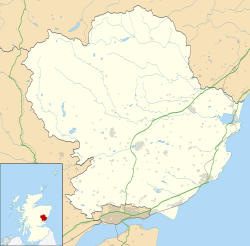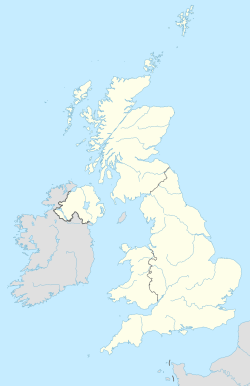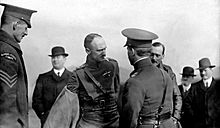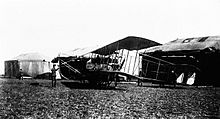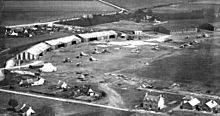RAF Montrose facts for kids
Quick facts for kids RAF Montrose
|
|||||||||
|---|---|---|---|---|---|---|---|---|---|
| Montrose, Angus in Scotland | |||||||||
|
Shown within Angus
|
|||||||||
| Coordinates | 56°43′44″N 002°27′06″W / 56.72889°N 2.45167°W | ||||||||
| Type | Royal Air Force station | ||||||||
| Site information | |||||||||
| Owner | Air Ministry | ||||||||
| Operator | Royal Air Force | ||||||||
| Controlled by | RAF Fighter Command RAF Flying Training Command |
||||||||
| Site history | |||||||||
| Built | 1913 | ||||||||
| In use | 1913-1952 | ||||||||
| Battles/wars | First World War European theatre of World War II |
||||||||
| Airfield information | |||||||||
| Identifiers | ICAO: X6MO | ||||||||
| Elevation | 10 metres (33 ft) AMSL | ||||||||
|
|||||||||
RAF Montrose was a special air base in Scotland. It was the very first military airfield in the United Kingdom. It opened on February 26, 1913. This base played a big part in both the First World War and the Second World War.
Contents
History of RAF Montrose
RAF Montrose in the First World War
In 1912, the British government planned to build several "Air Stations." These were bases for the Royal Flying Corps, which was the air force at the time. The first of these important bases was built at Montrose. Its job was to help protect the Royal Navy bases nearby.
On February 13, 1913, five planes from No. 2 Squadron started a long journey. They flew from RAF Farnborough all the way to Montrose. The trip was about 450 miles and took 13 days! They landed at Upper Dysart Farm on February 26, 1913. This made Montrose the first military airfield in the UK.
The first spot wasn't perfect, so the base moved to Broomfield Farm. By early 1914, three large hangars were built there. These hangars were special designs from the Indian Army.
When the First World War began in July 1914, No. 2 Squadron moved to France. One of their pilots, Lieutenant H.D. Harvey-Kelly, was the first to land in France after the war started. Another pilot, William Barnard Rhodes-Moorhouse, was the first pilot to receive the Victoria Cross. This is a very brave award, but he received it after he died in battle.
No. 2 Squadron never came back to Montrose. But many other squadrons used the base during the war. Montrose became a major training center for pilots. Pilots from America, Canada, and Britain all trained there.
Some Squadrons at Montrose during WWI
- No. 2 Squadron RFC (1913-1914)
- No. 25 Squadron (1915-1916)
- No. 80 Squadron (1917-1918)
- No. 83 Squadron (1917)
- 41st Aero Squadron (US Army Air Service) (1918)
Aircraft Flown at Montrose during WWI Many different types of planes were flown at Montrose. Some of them include:
- Avro 504
- Bristol F.2 B
- DH2
- Royal Aircraft Factory B.E.2
- Royal Aircraft Factory R.E.8
- Sopwith Camel
- Sopwith Pup
- Royal Flying Corps at Montrose
Between the World Wars
RAF Montrose closed down in 1920. But in 1924, some of its buildings were used again. They were used to fix and update Lewis machine guns.
In 1935, the British government decided to make the RAF stronger. This was because of a growing threat from Germany. They needed many more trained pilots. So, RAF Montrose reopened on January 1, 1936. It became No. 8 Flying Training School. About 800 pilots earned their 'wings' (meaning they became qualified pilots) at Montrose before the Battle of Britain. Many famous British fighter pilots from WWII trained here.
RAF Montrose in the Second World War
During the Second World War, RAF Montrose was very busy. Many fighter squadrons and the Fleet Air Arm used the base. Pilots from many different countries trained and served there. These included pilots from the Commonwealth, Poland, Czechoslovakia, America, Russia, Turkey, and Free French forces.
The base also helped defend the city of Edinburgh. Spitfire and Hurricane planes were stationed there for air defense.
RAF Montrose also flew missions to Norway. These missions included scouting, dropping supplies for the Norwegian resistance movement, and helping Special Operations Executive agents. On October 25, 1940, three German planes bombed the station. Five people died, 18 were hurt, and two hangars were destroyed. The pilots who died in training accidents are buried in a special cemetery nearby.
Famous Pilots at RAF Montrose during WWII Many brave pilots trained or served at Montrose, including:
- Wing Commander Brendan "Paddy" Finucane
- Flight Lieutenant Richard Hillary
- Flight Lieutenant George "Screwball" Beurling
- Group Captain Peter Townsend
Some Squadrons at Montrose during WWII
- No. 269 Squadron RAF (1939)
- No. 603 (City of Edinburgh) Squadron RAF (1940)
- No. 145 Squadron RAF (1940)
- No. 111 Squadron RAF (1940-1941)
- No. 310 Squadron RAF (Czech) (1941)
Aircraft Flown at Montrose during WWII Many different planes were used for training and operations, such as:
- Airspeed Oxford
- Avro Anson
- Hawker Hurricane
- Miles Master
- North American Harvard
- Supermarine Spitfire
- Westland Lysander
After the Wars
After the Second World War, activity at RAF Montrose slowed down. In 1948, it was home to No. 63 Maintenance Unit. This unit repaired aircraft. Planes were brought in and out by road because there were no paved runways. The base became very busy during the crisis in Hong Kong and the Korean War. RAF Montrose finally closed for good on June 4, 1952.
Mountain Rescue at Montrose
Even though Montrose is flat, the area around it has mountains. Plane crashes in the mountains were not uncommon. In January 1944, the Royal Air Force Mountain Rescue Service was formed. One of the first ten rescue teams was based at Montrose. This team helped with emergency rescues in Scotland. The team moved to nearby RAF Edzell and later to RAF Leuchars, where it remains today.
Accidents at the Airfield
In the early days of pilot training, there were many accidents. One American pilot said there was "a crash every day and a funeral every week." The graves at the local cemetery, Sleepy Hillock, show how many pilots died while learning to fly at Montrose.
Ghost Stories
Some people believe RAF Montrose is one of the most haunted places in Britain. A pilot named Lt Desmond Arthur died in a flying accident in 1913. People say his ghost haunts the officers' mess. There have also been claims of seeing other ghosts in pilot uniforms and hearing phantom planes. In 2010, some people even claimed to hear old wartime music and voices coming from a 70-year-old radio that wasn't plugged in!
Montrose Air Station Heritage Centre
In 1983, a group called the Montrose Air Station Heritage Trust was formed. They wanted to save the history of the air base. In 1992, they bought the old Watch Office and some land. They created the Montrose Air Station Heritage Centre. They have added more buildings and collections since then. You can still see some of the old buildings and hangars at the site today.


